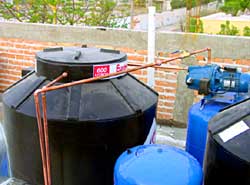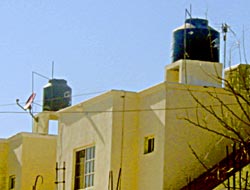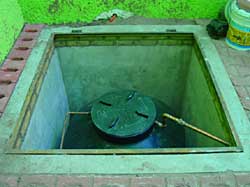|
Hot & Cold Water in Your Home |
|
|
Most of this article is taken from posts on MexConnect.com. It derives from questions asked by various participants (posters) and answered by Dr. Steven Fry Ph.D. (in Public Health and Environmental Chemistry) and Mr. Rex Conkright USA licensed plumbing contractor, retired. I have done some editing for clarity and added some background information and pictures. First, a little background information and some definitions Low Water Pressure is a problem almost everywhere in México. And in many places, water is not available 24/7. It may be on for a few hours each day, and sometimes not every day. For this reason many homes have a large storage tank for those dry times. Often the tank is on the roof so that gravity can increase the pressure in the kitchen and bathroom. Sometimes an electric pump is included to enhance the pressure. This article will address these issues. Water Heater Safety is largely overlooked in México. We'll tell you what you need to know for your protection. Lead Contamination There are unique things about common plumbing installations in México that increase your potential exposure to lead in tap water. There are easy workarounds. Here are some useful definitions:
water
tank = tanque
de agua Both the aljibe and pila are typically made with bricks and stucco. Sometimes a plastic tank (pictured below) is used other than on the roof in which case it is often called a tinaco no matter where it is located. In some areas a water tank is called a cistrerna no matter where it is located or how it is made |
|
|
|
|
|
Roof tinaco with a pressure pump. Valves allow tinaco water to bypass the pump in case of pump or electrical failure |
Tinacos on pedestals to increase pressure in a gravity system, no pressure pump |
|
|
|
|
Tinaco in the ground with the cover removed connected to the pump shown on the right |
Water heater, pressure pump and gas tank for the heater. Bypass valves allow street water to flow to the house in case of pump or electrical failure. |
|
Water Pressure POSTER: I found out today that many of the NoB commercial water faucets with a single "mixing valve" may not work well at all, and in fact reduce the volume of water in a home in Mexico down to a small dribble, especially a single story home without the advantage of additional height for "free fall" water pressure! This appears to be based on the fact that water pressure here in Mexico is not usually sufficient to operate the mixing valves efficiently. After I bought all good quality (Delta, etc.), manufactured shower heads, and sink units NoB for our remodel, I had to change them out for cheap Mexican units, until I get our in ground cistern and filter and water pressure pump installed. I sure didn't figure on that one! (smiling) The cheaper ($245 MX Peso) units work just fine for now. So this is just a "heads up" for those who may be planning the same retrofits, I have done. REX CONKRIGHT: It important to understand that a gravity fed water system only generates slightly less than one half pound of pressure for every foot of elevation to the water source, the rooftop tinaco here. I guesstimate that we only have about ten pounds of pressure at our downstairs kitchen and the wash basin in the down stairs half-bath, and about two pounds of pressure at the upstairs shower heads. It takes about ten or fifteen minutes for our outside automatic clothes washer to fill. The only way to get higher pressure is by having an electric water pressure pump installed, as shown n the pictures above. You will probably get about 30 pounds of water pressure. DR FRY: Bringing US ways of doing things to Mexico doesn't always work, or said another way: Mexicans do sometimes know what they are doing. In the USA, 60 psi is the standard, while Mexican pressure systems are typically set up at lower values: between 20 - 35 psi. Very consistently, we've found that when installing a pressure pump on an existing tinaco gravity feed system with typical Mexican plumbing materials, joints, and connections, the system develops new leaks if you pressurize to more than 35 - 40 psi. The leaks have occurred under floors, inside walls, and in places that were difficult to access and required some demolition of pretty one-of-a-kind tile, etc. Given the potential for leaks, demolitions, and repairs, it just is not worth it to try to crank up the pressures to 60 psi US city standards, and instead we find it better to default to US rural home-well conditions of 30 psi or less. Most customers have found that a range of 20 psi - 30 psi meets most of their needs without creating leaks. This is enough pressure to fill a washing machine fairly rapidly, and provides reasonable shower pressures. If you buy a pump system here in Mexico, we also recommend using the 2 adjusting nuts to get approximately a 4 psi working range of pressure under 30 or 35 psi - and adjust the air pressure in the bladder/diaphragm to within 2 psi of your lowest pressure. e.g. if you have a working range of 25 psi when the pump kicks-in and pump shut-off at 30 psi, then adjust the air pressure in the bladder/diaphragm to 23 - 25 psi. ** Hint: We've found most Mexican plumbers do not know how to make these adjustments. There are many instances where good NoB theory doesn't fit Mexican realities. More practical sidelights:
|
|
|
Water Heater Safety POSTER: What Mexican water heaters rarely have is an emergency popoff valve. A few months ago my maintenance guy was tinkering with the thermostat and it stuck. A couple hours later I went to water my plants and I boiled a bougainvillea before I realized the water was so hot it had backed up in the incoming cold water side. I immediately ran to the propane tank to cut it off and started opening faucets to bleed off pressure, the steam melted a plastic shower head. It was a miracle I happened to water that plants at that time of day otherwise ithe heater would have exploded and blown the end off the house. REX CONKRIGHT: All water heaters should be equipped with a T&P Valve (temperature & pressure relief valve). When either the temp or pressure gets too high, it opens to relive the problem. Great detailed information on T&P relief valve applications here. All water heaters built in the past few decades have a thermostat. It does not require any external power to operate. A device called a thermopile supplies the tiny amount of electricity to operate the thermostat. The thermopile is in the flame of the pilot light. The heat causes a few molecules from one pole of the thermopile to jump to the other pole, generating a tiny amount of electricity. It is a tiny amount, measured in micro-volts. It is enough to operate the thermostat though. As long as you have gas, and a pilot light flame the thermostat will function. Many self contained wall heaters, etc. use the same technology, no external power is required. It is worth noting that some older water heaters in Mexico are constructed without thermostats and without Temperature and Pressure (T&P) relief valves. If your heater has no thermostat or no T&P relief valve, then your system will need external piping vents to blow off steam when the water heater's burner is left "ON" too long. If the water boils in the tank, the steam escapes out the open external piping vents, eliminating the risk of explosions. If instead your system does not have open external piping vents, then another issue can arise anytime your system is emptied. If you are using a pressurized system or system with no vents open to air, when you refill the tank, you need to remove the air from the tank before igniting the heater. Open some valves in the house when filling an empyt tank to let the air escape. When all of the valves stop blowing the air and begin to deliver only water, then the system is fully charged and functional. External piping vents are necessary for gravity fed systems, and they also eliminate the need for a T&P relief valve. If the heater's thermostat gets stuck in the open, or burn position, the water in the tank can superheat or start boiling. As high pressure steam builds in an un-vented system that has no T&P relief valve, the hot water heater tank finally fractures, and the remaining water in the tank immediately flashes into steam with deadly explosive force.
|
|
|
Lead Contamination POSTER: I wonder how many faucets bought in Mexico and plumbing connections still have lead in them. Every time I see a plumber working in Mexico I pick up his solder, and every time it has been 50/50 ( 50% lead and 50% tin) which has been outlawed in the US for a number of years. DR. FRY: The issue of lead in water leaching from lead soldered joints comes primarily from basic (alkaline) hard water that has been standing in the pipe overnight or longer. If you are drinking tap water, whether here in Mexico or in Canada or the United States, it is best to flush the drinking water line first thing in the morning. Since a typical toilet flush draws between 1.6 - 5 gallons, flushing a toilet on that part of a house's plumbing, also flushes out the lead that accumulated overnight. 100 feet of normal 1/2 inch pipe only holds about 2 gallons of water. This means that a single toilet flush in the morning easily removes the accumulated lead from that circuit. If you have very large 3/4 inch pipes, (unusual), then every 22 feet of pipe holds 1 gallon. If there is 50 feet of normal 1/2 in. tubing between your tinaco and your kitchen sink, (a typical run of pipe) then running 1 gal. of water through the faucet flushes out the lead. If your faucet has modest flow, then it typically takes a minute of rinsing dishes, etc to flush the line before drinking. Since the average American uses over 500 gal of water a day, the issue of lead accumulating in drinking water from lead soldered joints really is quite minimal. Mexicans use about 375 gal of water per day per person, so, even with Mexican levels of water usage, lead from drinking tap water is not usually a significant risk. There has been some evidence that basic (alkaline) water sitting overnight (or more than 6 hours) in chilled-water drinking fountains may have elevated lead levels from all the soldered joints in the refrigeration plumbing. The solution to this is to run the drinking fountain for a minute after it has sat unused overnight. Our significant lead exposures actually come from typical fishing (handling and biting lead sinkers/weights), from lead in soil and dust, and lead-based paints in older constructions. For comparison purposes, the typical risks from lead in home drinking water are quite low: The health risks from breathing soot particles from passing buses, radiation exposure from airplane flights, second hand smoke from tobacco smokers, from radon exposure, from living at altitudes over 5,000 feet, and regular exposure to sunshine, each pose greater health risks for most people than lead in drinking water. The PNAs from grilling a hamburger or steak also represent greater health hazards than typical lead levels in drinking water. The toluene that bleeds out of common construction adhesives presents greater health risks than typical lead levels in home drinking water. Breathing the THMs present in chlorinated US drinking water during a typical shower presents greater health risks than typical lead lead levels in home drinking water. If your house has (very old) lead pipes, then all of the above descriptions of health risks do not apply. There are a few interesting quirks and exceptions for plumbing-lead in water that may be specific to Mexico. It is common to fill a pot water and start cooking beans with water drawn first thing in the morning. Even though we do not boil the bean water to dryness, the lead from alkaline water (sitting in pipes more than 6 hours), becomes concentrated in the beans. Since the initially-dry beans absorb a lot of water, they absorb lead along with the water. Ingested lead is stored in fatty tissues like liver, brain, marrow, etc - and lead also deposits in bones. Our bodies absorb the lead we eat, and they eliminate ingested lead very, very slowly, through fingernail and hair growth, so, once consumed, we tend to accumulate lead over time. This is a major reason why we want to avoid ingesting lead and other heavy metals - in addition to cognitive losses, neural system problems, etc. (No biting fishing weights to crimp them - and no licking your fingers after handling lead fishing weights.) Because the beans absorb so much water, it really would not be a good thing to daily eat beans cooked in the first draw of water every morning from copper plumbing. See the next reply for "The rest of the story". Past and current US EPA drinking water rules and ANSI/NSF Standard 61: Drinking Water System Components allow up to 8% lead in plumbing fixtures, so, most people imagine that they have no lead exposure, by buying copper piping and modern fixtures. If you have alkaline tap water, the same rule applies: flush your drinking water lines EVERY MORNING before drinking or cooking with that water, due to lead in what we imagine to be lead-free fixtures. Also flush lines if they sit with alkaline (or acidic) water for over 6 hours. Since basically all metal faucets have some lead leaching out after sitting unused for 6 hours, it is important to gently flush them before drawing drinking water. Running water for 5-10 sec typically flushes most fixtures. This is especially true if you have young children drinking the water - or eating foods cooked in such water (especially foods that absorb water like dry beans). Children's brain development is definitely harmed by even small lead exposures - and it really is a minor thing to develop a habit of running the tap briefly before drawing drinking or cooking water. |
|



